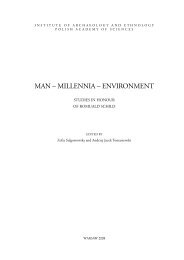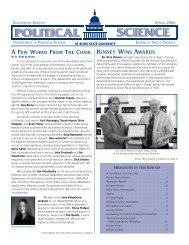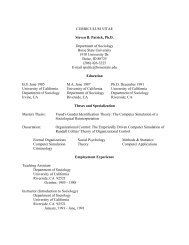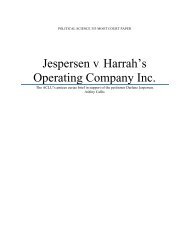From Incivility to Outrage - College of Social Sciences & Public ...
From Incivility to Outrage - College of Social Sciences & Public ...
From Incivility to Outrage - College of Social Sciences & Public ...
You also want an ePaper? Increase the reach of your titles
YUMPU automatically turns print PDFs into web optimized ePapers that Google loves.
Downloaded by [Boise State University] at 17:30 21 December 2011<br />
Political Discourse in Blogs, Talk Radio, and Cable News 35<br />
presence <strong>of</strong> Rush Limbaugh as a high-pr<strong>of</strong>ile counterexample, hosts were on average more<br />
moderate than their audiences. Politically, the radio hosts themselves were a mix <strong>of</strong> ideological<br />
and partisan backgrounds, and more were actually Democrats than Republicans<br />
(Kohut, Zukin, & Bowman, 1993, p. 14). What they describe is like nothing we listened <strong>to</strong><br />
in 2009. There are a handful <strong>of</strong> liberal and moderate talk shows at the local level, but all <strong>of</strong><br />
the leading nationally syndicated shows <strong>to</strong>day are extremely conservative and vituperative<br />
in <strong>to</strong>ne. While talk radio is becoming more conservative and the audiences are increasing,<br />
a significant market has yet <strong>to</strong> emerge for liberal talk radio (Mayer, 2004).<br />
More evident <strong>to</strong> those following the media business is the dramatically changing landscape<br />
<strong>of</strong> media spaces and audiences. The most powerful hint that outrage is on the rise<br />
is that cable news analysis shows and political blogs were not even in existence a decade<br />
ago, and political talk radio did not grow in number or popularity until the 1990s. Father<br />
Coughlin may have spawned controversy decades ago, but programming <strong>of</strong> that ilk was<br />
rare. Now outrage venues abound and their audience continues <strong>to</strong> grow. Tens <strong>of</strong> millions<br />
<strong>of</strong> people a day consume talk radio alone. The combined cable audiences are smaller but<br />
still impressive. The blog world is splintered in<strong>to</strong> a staggering number <strong>of</strong> sites, though the<br />
<strong>to</strong>p sites (which include the ones we studied) attract a lion’s share <strong>of</strong> the traffic (Hindman,<br />
2009). Today the number <strong>of</strong> outrage media outlets and the size <strong>of</strong> outrage audiences are<br />
both impressive and unprecedented.<br />
Conclusion<br />
By looking at “outrage,” this research casts a much broader net than previous work on incivility.<br />
As we have noted, the most <strong>of</strong>t-cited pieces in the field, Mutz and Reeves (2005),<br />
Mutz (2007), and Brooks and Geer (2007), concern themselves with effects rather than content.<br />
Even so, the incivilities introduced in their experimental designs address only three <strong>of</strong><br />
our 13 variables: emotional display, verbal fighting/sparring, and insulting language. This<br />
is not a shortcoming <strong>of</strong> their valuable work per se, but it highlights the degree <strong>to</strong> which<br />
those seeking <strong>to</strong> understand the effects <strong>of</strong> negativity or incivility on the public must consider<br />
the many ways that hostility and disrespect permeate the political landscape. Future<br />
research on effects would be well served <strong>to</strong> investigate whether audiences respond similarly<br />
<strong>to</strong> more dramatic forms <strong>of</strong> outrage as they do <strong>to</strong> the milder forms that research has<br />
probed thus far.<br />
Our research also indicates that while previous work has looked extensively at candidate<br />
(or mock candidate) statements, debates, and advertisements, this is not the only place<br />
political acrimony resides. Campaign-related rhe<strong>to</strong>ric is a modest part <strong>of</strong> the overall volume<br />
<strong>of</strong> antagonistic speech. The texture <strong>of</strong> our broader political culture must be considered.<br />
How does the general tenor <strong>of</strong> political discourse shape attitudes about politics, political<br />
figures, interest in participating, and our beliefs about others with whom we disagree? Even<br />
those whose primary concern is campaign communications ought <strong>to</strong> fac<strong>to</strong>r the broader discursive<br />
landscape in<strong>to</strong> account, as involvement in this culture most certainly informs how<br />
audiences will respond <strong>to</strong> incivility when it emerges in the campaign context. Perhaps, for<br />
example, those who engage with a greater amount <strong>of</strong> high outrage political information—<br />
an Olbermann viewer and regular reader <strong>of</strong> Wonkette, for example—demonstrate less <strong>of</strong><br />
an aversion <strong>to</strong> rough and tumble political skirmishes between candidates. Or one might<br />
hypothesize that they are more averse <strong>to</strong> outrageous campaign communications, feeling<br />
strongly that such attacks have a place, but in the world <strong>of</strong> political entertainment.<br />
Although we have emphasized measurements <strong>of</strong> outrage commentary, what is ultimately<br />
important are the larger implications <strong>of</strong> these behaviors and trends. The media







